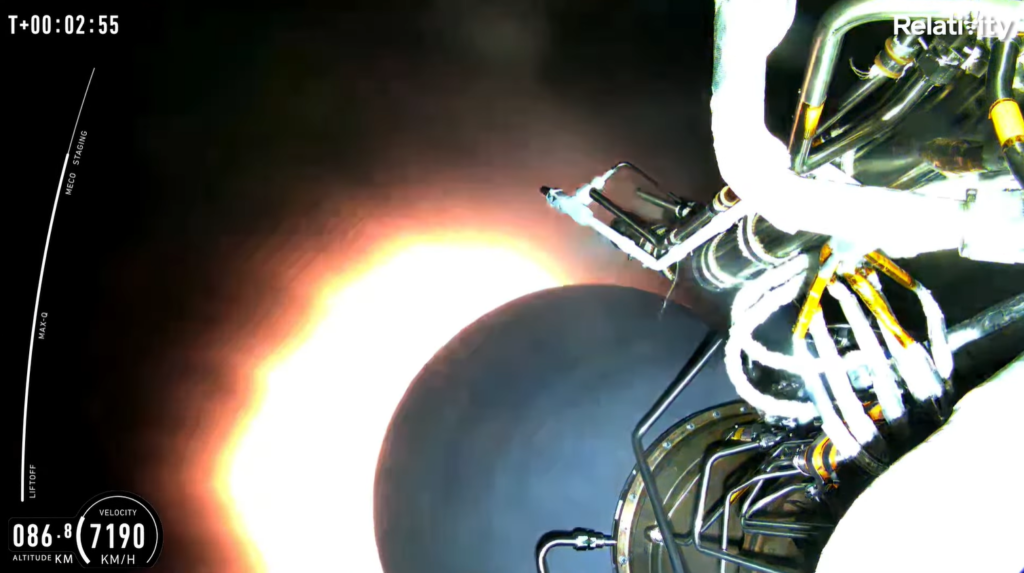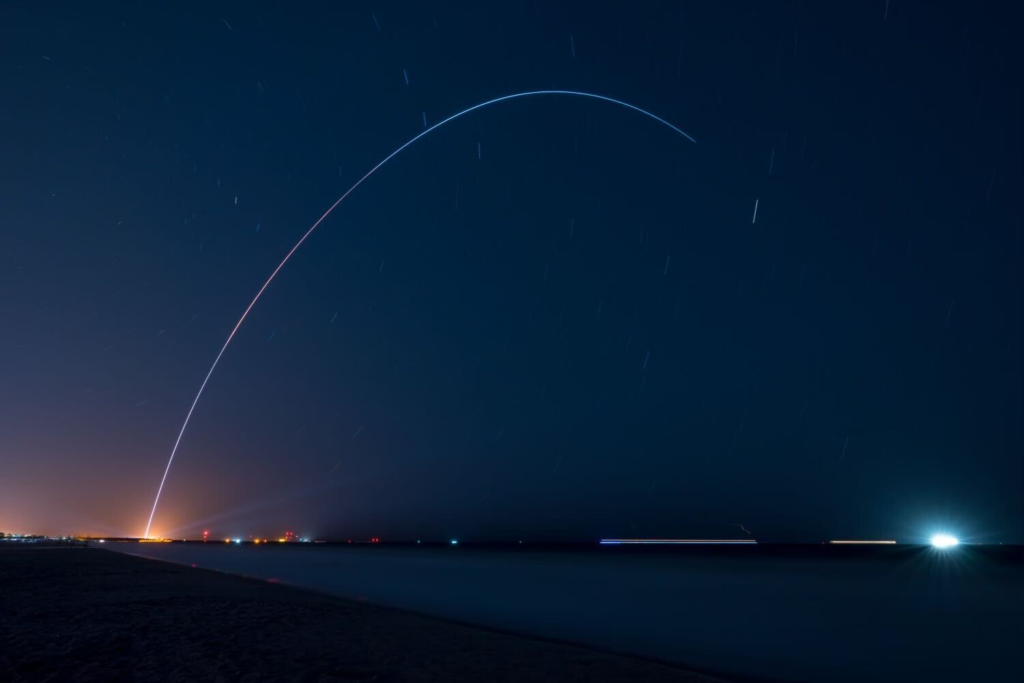
What Happened On Terran 1’s First Orbital Test Flight?
Relativity Space is a company trying to reinvent the manufacturing process for orbital class rockets using 3D printing. Founded in 2015, they have been developing, creating, and testing different parts of their small lift launch vehicle Terran 1 for around 8 years. Yesterday, however, they attempted the most important test in the company’s history.
Last night, Terran 1 lifted off from Launch Complex 16 at Cape Canaveral Space Force Station in Florida on a test flight named “Good Luck, Have Fun”. The rocket ended up flying past max q and even stage separation before an anomaly occurred close to 3 minutes into the launch. This ended up stopping the rocket from reaching orbit however still a massive success for Relativity.
The rocket was 85% 3D printed by mass making this launch not only the first for the company but also the first attempted orbital flight with a printed rocket. Here I will go more in-depth into the flight profile, where the problem occurred, what to expect in the future, and more.
First Launch

Earlier in the month on the 11th Relativity attempted to launch Terran 1 but it was scrubbed due to various reasons. Thankfully, yesterday, after a few holds in the countdown, Terran 1 lifted off at 11:25 p.m. Eastern time. Seconds in and it quickly cleared the pad and began accelerating and gaining altitude. Around 30 seconds in everything was nominal as Terran 1 continued to speed up reaching an altitude of around 1.4 kilometers high. Next and most significantly, at 1 minute and 25 seconds into the mission Terran 1 reached Max Q with no problems. This in itself was a very big deal as Max Q is the point at which the rocket experiences the most amount of stress during a mission. Being a test of the first 3D printed rocket, there were a lot of questions surrounding its strength and what it could actually handle.
Moving on, after reaching Max Q, Terran 1 kept going as it approached its next major mission event. At 2 minutes and 44 seconds into the mission, the live stream partially cuts out and there is no view however the main engine of the Terran 1 first stage cuts off. Just seconds later and the first and second stage separate before a view of the second stage engine shows up 2 minutes and 50 seconds in. This is where the main problem seems to have occurred. You can first see the engine attempting to ignite for around 10 seconds. At one point it looks to be almost producing the proper thrust but over the next few seconds, it slowly dies out. By around 3 minutes and 4 seconds into the launch, it looked like the engine was not producing any thrust. About 15 seconds later you can even seen a large sputter as it ignites for just a second.
In the bottom left, you can see the telemetry which shows the stage slowing. Finally, 5 minutes into the launch Mission Control declared an anomaly with the second stage. After, Relativity didn’t immediately disclose additional details about the failure. Its important to point out that this mission did not include any customer payloads and instead only a memento.
The engine responsible for the anomaly is an Aeon Vacuum engine. Relativity manufactures multiple engines, including Aeon 1, Aeon R and Aeon Vac. All of which, like the rocket structure, are 3D-printed, meant to enhance mission reliability by reducing part count in engine combustion chambers, igniters, turbopumps, reaction control thrusters, and vehicle pressurization systems. All Aeon engines use liquid oxygen + liquid natural gas as propellants. The specific engine that experienced issues is very similar to the engines used on the first stage with one of the main differences being the large vacuum nozzle. Looking at the footage again, some belive that a faulty main oxygen valve was responsible. Ignitor seemed to be doing just fine, but there was just not enough oxygen to sustain combustion. This is just a theory that we should learn more about soon when Relativity releases additional information.
Either way, the mission was still a major success. Soon after it launched, Relativity tweeted saying, “Today’s launch proved Relativity’s 3D-printed rocket technologies that will enable our next vehicle, Terran R. We successfully made it through Max-Q, the highest stress state on our printed structures. This is the biggest proof point for our novel additive manufacturing approach. Today is a huge win, with many historic firsts. We also progressed through Main Engine Cutoff and Stage Separation. We will assess flight data and provide public updates over the coming days.”
What’s Next?

With this mission complete, Relativity just gained a ton of invaluable flight data of both the good and the bad. In the coming weeks, they will be conducting a post launch investigation to figure out not only what went wrong but how to ensure it doesn’t happen again. This process will involve a lot of ground testing with the engine trying to replicate what happened on the launch. Hopefully, the problem is a simple error that can easily be fixed for the next attempt.
As a two-stage, 110ft. tall, 7.5 ft. wide, expendable rocket, Terran 1 is the largest 3D printed object to exist and to attempt orbital flight. While this first launch used a Terran 1 that was 85% 3D printed by mass, Relativity’s goal is for the rocket to be 95% 3D printed. As far as design, Terran 1 has nine Aeon engines on its first stage, and one Aeon Vac on its second stage. The big moment in this launch was verifying the capabilities of 3D printing. In this case, Relativity has been designing and working on a new factory specifically for this process. Relativity’s proprietary Factory of the Future centers on Stargate, the world’s largest metal 3D printers, that create Terran 1, and Terran R, from raw material to flight in 60 days. Relativity’s Stargate printers’ patented technology enables an entirely new value chain and innovative structural designs that make Terran 1 and Terran R possible. By developing its Factory of the Future and rockets together, Relativity believes it can accelerate its ability to improve design, production, quality, and speed.
They point out that for over half a century, aerospace manufacturing has relied on large factories, fixed tooling, complex supply chains, and extensive manual labor to build costly rockets comprised of 100,000+ parts in 2 years or longer. In order to accelerate innovation in the industry, Relativity built its Factory of the Future, the first aerospace platform to automate rocket manufacturing, vertically integrating intelligent robotics, software, and data-driven 3D printing technology. Incorporating Stargate with AI-driven controls, their Factory of the Future works to continuously optimize production, resulting in greatly compounded quality and time improvements, lower costs, and product designs previously not possible. As time goes on, they will continue to try and refine this process as much as possible.
In addition to work on Terran 1 and the next launch, Relativity is also working hard on Terran R, a larger fully reusable 3D printed rocket. Created in the same factory, Terran R is fully reusable including its engines, first stage, second stage, and payload fairing, and will be capable of launching over 20,000kg to low Earth orbit (LEO) in a reusable configuration. Currently, the company is still targeting next year for the first launch of this rocket. Last year, Relativity signed a multi-year, multi-launch Launch Services Agreement (LSA) with OneWeb. Under the agreement, Relativity will launch OneWeb’s low Earth orbit (LEO) satellites on Terran R, the first fully reusable and entirely 3D printed rocket, starting in 2025. These launches will support OneWeb’s deployment of its Gen 2 satellite network, which will add capacity and fresh capabilities to build upon the initial constellation of 648 satellites the company is currently building out.
Terran R will launch OneWeb missions from Launch Complex 16, Relativity’s site at Cape Canaveral Space Force Station, where Terran 1 just lifted off. As a medium-heavy lift, fully reusable launch vehicle made for growing satellite constellation launch demand and eventually multiplanetary transport, Terran R is trying to provide both government and commercial customers affordable access to space, in LEO and beyond. With the addition of its multi-launch agreement with OneWeb, Relativity has a total of five signed customers for Terran R, including multiple launches and totaling more than $1.2B in backlog.
Not only this, but late last year, the company unveiled the latest iteration of its first-of-its-kind proprietary manufacturing platform, Stargate 4th Generation metal 3D printers. The newest Stargate printer technology defies traditional printing constraints by moving horizontally as it feeds multiple wires into a single print head to print orbital rockets. Relativity is developing customized software and machine learning techniques to allow these printers to print more complex and significantly larger metal products, with improved print speed and reliability. Stargate 4th Generation printers also radically simplify manufacturing supply chains, as they are capable of printing a rocket with 100x fewer parts in a matter of months. All of which will use the information gained from yesterday’s launch as they continue to grow and attempt new things.
Conclusion
Relativity Space just attempted the most significant test in the company’s history. While not 100% successful, the Terran 1 test article got all the way to second stage engine ignition where problems arose. In the coming days, we can expect more information from the company as they figure out what went wrong. We will have to wait and see how it progresses and the impact it has on the space industry.
